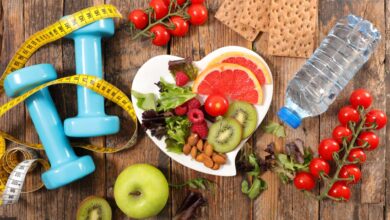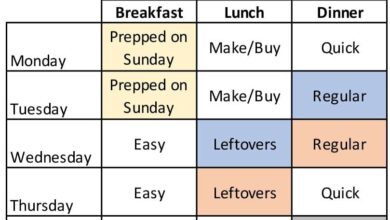
Essential Guide to Fiber: Your Digestive Health Toolkit
Essential Guide to Fiber: We all know fiber is good for us, but do we really understand its power? It’s not just about keeping things moving smoothly, though that’s definitely a key benefit. Fiber is a superhero in disguise, working tirelessly to keep our bodies healthy from the inside out.
From managing weight and blood sugar to protecting against chronic diseases, fiber plays a crucial role in maintaining overall well-being. This guide will delve into the fascinating world of fiber, exploring its different types, benefits, and how to incorporate it into your daily life for optimal health.
What is Fiber?
Fiber is a type of carbohydrate that the human body cannot digest. It is found in plant-based foods and plays a crucial role in maintaining digestive health and overall well-being. Unlike other carbohydrates, fiber does not break down into sugars that the body can absorb.
Instead, it passes through the digestive system largely intact, providing numerous benefits along the way.
Types of Fiber
Fiber can be categorized into three main types: soluble, insoluble, and functional fiber. Each type offers unique benefits and is found in various food sources.
- Soluble fiberdissolves in water, forming a gel-like substance in the digestive tract. It helps regulate blood sugar levels, lower cholesterol, and promote a feeling of fullness. Some common sources of soluble fiber include oats, beans, lentils, apples, and citrus fruits.
- Insoluble fiberdoes not dissolve in water and adds bulk to the stool, aiding in regular bowel movements. It can also help prevent constipation and promote digestive regularity. Good sources of insoluble fiber include whole grains, vegetables like broccoli and carrots, and nuts and seeds.
A good source of fiber is important for maintaining a healthy digestive system, especially during pregnancy. However, some yoga poses can put pressure on your abdomen and should be avoided, especially during pregnancy. Check out this helpful guide on yoga poses to avoid during pregnancy to ensure you’re practicing safely.
Remember, your doctor can provide personalized advice on the best dietary and exercise practices for your pregnancy journey.
- Functional fiberrefers to isolated or extracted fiber that is added to foods or supplements. It can provide similar benefits to soluble and insoluble fiber. Examples of functional fiber include psyllium husk, inulin, and cellulose.
Role of Fiber in Digestion
Fiber plays a vital role in maintaining a healthy digestive system. It acts as a prebiotic, providing food for beneficial bacteria in the gut. These bacteria help break down fiber and produce short-chain fatty acids (SCFAs), which are essential for gut health and overall well-being.
Fiber promotes regular bowel movements, prevents constipation, and helps maintain a healthy balance of gut bacteria.
Recommended Daily Intake of Fiber
The recommended daily intake of fiber varies depending on age and gender. However, most adults should aim for 25-30 grams of fiber per day.
| Age Group | Recommended Daily Fiber Intake (grams) |
|---|---|
| Children (1-3 years) | 19 |
| Children (4-8 years) | 25 |
| Children (9-13 years) | 31 |
| Teenagers (14-18 years) | 38 (males), 26 (females) |
| Adults (19-50 years) | 38 (males), 25 (females) |
| Adults (51+ years) | 30 (males), 21 (females) |
Benefits of Fiber
Fiber is a type of carbohydrate that the body can’t digest. This indigestible carbohydrate has many benefits for overall health, from promoting weight management to reducing the risk of chronic diseases.
Fiber is a crucial part of a balanced diet, and while it’s often associated with leafy greens and whole grains, there are surprising ways to boost your intake. For example, if you’re a fan of Chipotle, you can find some great fiber-rich options by following this guide to healthy ways to order Chipotle.
Of course, the best way to get your daily fiber is through a diverse range of fruits, vegetables, and whole grains, but these tips can make your favorite fast food a little bit healthier!
Fiber’s Role in Weight Management
Fiber can help you feel fuller for longer, which can help you eat less and manage your weight. This is because fiber slows down the rate at which food moves through your digestive system, which helps you feel satisfied after eating.
Fiber’s Impact on Blood Sugar Control
Fiber can help regulate blood sugar levels by slowing down the absorption of sugar into the bloodstream. This is especially beneficial for people with diabetes or those at risk of developing the condition.
Fiber and Cholesterol Levels
Fiber can help lower cholesterol levels by binding to cholesterol in the gut and preventing its absorption into the bloodstream. This can help reduce the risk of heart disease.
Fiber and Chronic Disease Prevention, Essential guide to fiber
Fiber plays a vital role in reducing the risk of several chronic diseases, including:
- Heart disease:Fiber helps lower cholesterol levels, which is a major risk factor for heart disease.
- Type 2 diabetes:Fiber helps regulate blood sugar levels, which is important for preventing and managing type 2 diabetes.
- Certain types of cancer:Some studies suggest that a high-fiber diet may reduce the risk of certain types of cancer, such as colorectal cancer.
Fiber’s Influence on Gut Health
Fiber acts as food for the beneficial bacteria in your gut, known as probiotics. These bacteria play a crucial role in maintaining a healthy digestive system.
Fiber’s Impact on Digestive Regularity
Fiber adds bulk to your stool, which helps to prevent constipation and promote regular bowel movements.
Incorporating Fiber into Your Diet
Adding fiber to your diet doesn’t have to be complicated. It’s about making small, gradual changes to your meals and snacks to increase your overall intake. Start by incorporating high-fiber foods into your daily routine, and you’ll be well on your way to enjoying the benefits of fiber.
Sample Meal Plan with High-Fiber Foods
Here’s a sample meal plan that incorporates high-fiber foods for breakfast, lunch, and dinner. This is just a starting point, and you can adjust it based on your preferences and dietary needs.
- Breakfast:Oatmeal with berries and nuts (30 grams of fiber)
- Lunch:Lentil soup with whole-wheat bread (25 grams of fiber)
- Dinner:Salmon with roasted vegetables and brown rice (20 grams of fiber)
Tips for Gradually Increasing Fiber Intake
Increasing your fiber intake too quickly can lead to digestive discomfort. To avoid this, it’s essential to increase your fiber intake gradually over time.
- Start slowly:Begin by adding a few extra grams of fiber to your diet each day. You can do this by adding more fruits, vegetables, or whole grains to your meals.
- Drink plenty of water:Fiber absorbs water, so it’s crucial to drink plenty of fluids throughout the day to prevent constipation.
- Listen to your body:Pay attention to how your body reacts to increased fiber intake. If you experience any discomfort, reduce your fiber intake slightly and gradually increase it again.
- Choose soluble and insoluble fiber:Aim for a balance of both types of fiber. Soluble fiber dissolves in water and forms a gel-like substance in your gut, while insoluble fiber doesn’t dissolve and adds bulk to your stool.
High-Fiber Foods by Food Group
Here’s a list of high-fiber foods categorized by food group:
Fruits
- Raspberries (8 grams per 1 cup)
- Pears (6 grams per medium pear)
- Apples (4 grams per medium apple)
- Bananas (3 grams per medium banana)
- Strawberries (3 grams per 1 cup)
Vegetables
- Broccoli (5 grams per 1 cup cooked)
- Brussels sprouts (4 grams per 1 cup cooked)
- Spinach (4 grams per 1 cup cooked)
- Carrots (3 grams per 1 cup cooked)
- Green beans (3 grams per 1 cup cooked)
Grains
- Whole wheat bread (4 grams per slice)
- Oatmeal (5 grams per 1/2 cup cooked)
- Brown rice (3 grams per 1/2 cup cooked)
- Quinoa (5 grams per 1/2 cup cooked)
- Popcorn (1.5 grams per 1 cup popped)
Legumes
- Lentils (16 grams per 1 cup cooked)
- Black beans (15 grams per 1 cup cooked)
- Kidney beans (15 grams per 1 cup cooked)
- Chickpeas (12 grams per 1 cup cooked)
- Split peas (16 grams per 1 cup cooked)
Fiber and Supplements
Fiber supplements can be a helpful tool for increasing your fiber intake, particularly if you struggle to get enough through diet alone. However, it’s essential to understand both the potential benefits and drawbacks of these supplements.
Types of Fiber Supplements
Fiber supplements are available in various forms, each containing different types of fiber.
- Psyllium husk:A soluble fiber derived from the husks of the psyllium plant. It absorbs water in the gut, forming a gel-like substance that helps regulate bowel movements. It is commonly found in brands like Metamucil and is often used to treat constipation.
You know that feeling of being full and satisfied after a meal? That’s often thanks to fiber, the unsung hero of our digestive system. And when it comes to fiber-rich meals, I’m always reaching for a delicious and nutritious bowl of mushrooms, brussels sprouts, tofu, and grains.
It’s a combination that packs a punch of fiber, protein, and essential vitamins and minerals. So, next time you’re looking for a meal that will keep you feeling full and energized, consider adding a fiber-rich bowl like this to your menu.
- Methylcellulose:A synthetic fiber that functions similarly to psyllium husk, forming a gel in the gut to promote regularity. It is available in various forms, including capsules and powders.
- Wheat dextrin:A soluble fiber derived from wheat, often used in weight management supplements. It is believed to slow down digestion and promote a feeling of fullness.
- Inulin:A soluble fiber found naturally in plants like chicory root. It is often used as a prebiotic, promoting the growth of beneficial bacteria in the gut.
- Polydextrose:A synthetic fiber that is often used as a bulking agent in food products. It is generally well-tolerated and can help promote regularity.
Recommended Dosages
The recommended dosage of fiber supplements varies depending on the type of fiber and your individual needs.
It’s crucial to follow the directions on the product label and consult with your doctor or a registered dietitian to determine the appropriate dosage for you.
Generally, it’s recommended to start with a low dose and gradually increase it as needed.
Potential Side Effects
While fiber supplements can be beneficial, they can also cause some side effects, especially if taken in large doses or without adequate water intake. Common side effects include:
- Gas and bloating:As fiber ferments in the gut, it can produce gas, leading to bloating and discomfort.
- Stomach cramps:Sudden increases in fiber intake can cause stomach cramps and discomfort.
- Diarrhea:Excessive fiber intake can lead to loose stools or diarrhea.
- Dehydration:Fiber absorbs water in the gut, so it’s essential to drink plenty of fluids when taking fiber supplements.
- Interactions with medications:Fiber supplements can interfere with the absorption of some medications, so it’s crucial to consult with your doctor if you are taking any medications.
Effectiveness of Fiber Supplements
Fiber supplements can be effective in increasing fiber intake and promoting regularity. However, they are not a substitute for a healthy diet rich in whole foods.
Dietary fiber is generally preferred, as it provides a wider range of nutrients and benefits compared to supplements.
Fiber supplements can be a helpful tool for individuals who struggle to meet their fiber needs through diet alone. They can also be beneficial for specific conditions like constipation. However, it’s essential to use them appropriately and consult with a healthcare professional to ensure they are safe and effective for you.
Fiber and Hydration

Fiber is a vital component of a healthy diet, but it’s crucial to remember that it requires adequate hydration to work effectively. When you increase your fiber intake, you’re essentially adding bulk to your digestive system, and this bulk needs sufficient water to move smoothly through your body.
The Importance of Hydration with Increased Fiber Intake
When you consume more fiber, your body needs more water to help break down the fiber and move it through your digestive system. Insufficient hydration can lead to constipation, bloating, gas, and other digestive discomforts. This is because fiber absorbs water in the gut, and if there’s not enough water available, the fiber can become too dense and difficult to pass.
Tips for Staying Hydrated
Staying hydrated throughout the day, especially when consuming high-fiber meals, is essential for digestive health. Here are some helpful tips:
- Drink water consistently throughout the day.Aim for 8 glasses of water daily, but adjust this based on your individual needs and activity levels.
- Carry a reusable water bottle and refill it frequently.This makes it easier to stay hydrated on the go.
- Choose water over sugary drinks.Sugary drinks can actually dehydrate you.
- Include water-rich fruits and vegetables in your diet.Fruits like watermelon, strawberries, and cucumbers are excellent sources of hydration.
- Drink water before, during, and after meals.This helps to keep your digestive system moving smoothly.
Dehydration Symptoms and Prevention
Dehydration can have various symptoms, including:
- Constipation
- Headaches
- Fatigue
- Dry mouth
- Dark urine
- Dizziness
If you experience any of these symptoms, it’s important to drink plenty of water to rehydrate.
To prevent dehydration, it’s crucial to listen to your body and drink water regularly, especially when you’re feeling thirsty or after consuming high-fiber meals.
Fiber and Exercise
Fiber and exercise are a dynamic duo when it comes to overall health and well-being. While fiber fuels your digestive system, exercise strengthens your muscles and cardiovascular system. Together, they create a synergistic effect that can enhance your energy levels, improve your mood, and reduce your risk of chronic diseases.
Exercise Performance and Recovery
Fiber can play a significant role in enhancing exercise performance and recovery. By regulating blood sugar levels, fiber helps to provide a steady stream of energy during workouts. This can help you train longer and harder, improving your endurance and strength.
Fiber also aids in digestion and nutrient absorption, which can support muscle recovery and growth.
“A high-fiber diet can help improve exercise performance by regulating blood sugar levels and providing sustained energy.”
Exercise Routines That Complement a High-Fiber Diet
Here are some examples of exercise routines that complement a high-fiber diet:
- Cardiovascular Exercise:Engaging in regular cardiovascular exercise, such as brisk walking, running, swimming, or cycling, helps to improve heart health, burn calories, and enhance overall fitness. A high-fiber diet provides sustained energy for these activities, helping you push through your workouts.
- Strength Training:Strength training, involving exercises like weightlifting or bodyweight exercises, helps build muscle mass and increase bone density. Fiber’s role in nutrient absorption supports muscle growth and repair after strength training sessions.
- Yoga and Pilates:These practices combine stretching, strength training, and mindfulness. A high-fiber diet can aid in flexibility and balance, enhancing the benefits of yoga and Pilates.
Conclusive Thoughts: Essential Guide To Fiber
As you embark on your fiber-rich journey, remember that consistency is key. Small changes can make a big difference. Listen to your body, adjust your intake as needed, and embrace the power of this essential nutrient. Fiber is not just about digestion; it’s about a healthier, happier you.






